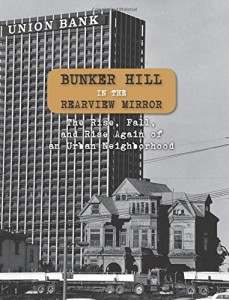 Bunker Hill in the Rearview Mirror: The Rise, Fall, and Rise Again of an Urban Neighborhood Bunker Hill in the Rearview Mirror: The Rise, Fall, and Rise Again of an Urban Neighborhood
During its history, the area of Downtown Los Angeles known as Bunker Hill has been viewed in many different ways; inaccessible, upscale, run-down, blighted, erased, renewed. These perceptions over the decades have always been open to interpretation and either agreed with or challenged. An area that has been subject to more change than any other place in the city, it has arguably invoked more passion and reverence than any other Los Angeles neighborhood, while inspiring equal amounts of disdain. Bunker Hill in the Rear-View Mirror: The Rise, Fall, and Rise Again of an Urban Neighborhood, an exhibit at the Los Angeles Public Library’s Central Library on display from April 2015 – April 2016, uses photographs, news articles, recollections and unique ephemera from LAPL Special Collections to illustrate the complex story of Bunker Hill, from its heyday in the 1880’s to its redevelopment in the 1960’s and 70’s. Curated by librarians Christina Rice, Photo Collection, and Emma Roberts, Art & Music/Rare Books, the exhibit is enhanced by this companion catalog with contributing essays by Adrian Scott Fine, Nathan Marsak, Merry Ovnick, Meredith Drake Reitan, and Donald R. Spivack. |
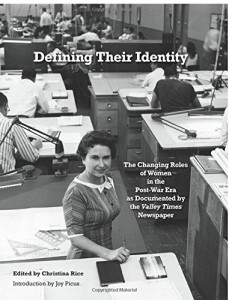 Defining Their Identity: The Changing Roles of Women in the Post-War Era as Documented by the Valley Times Newspaper Defining Their Identity: The Changing Roles of Women in the Post-War Era as Documented by the Valley Times Newspaper
The popular view of women in the years following World War II has come to be of homemakers like television’s Donna Reed and June Cleaver who maintained picture perfect households in suburban settings. In many cases this was indeed the primary role assumed by women of the era, but it wasn’t the only one. Women pursued advanced degrees, became professionals, held office, excelled in sports, fought for equal rights, and became civically involved, and often while running those households. The San Fernando Valley has come to exemplify the post-War suburban growth that took place throughout the country and the Valley Times newspaper was there to document this expansion along with the Valley’s dynamic women in their various roles. Now, the exhibit and companion catalog, Defining Their Identity: The Changing Roles of Women in the Post-War Era, explores the changing roles of women through the lens of the Los Angeles Public Library’s Valley Times’ image archive. |
 Discovery, Disaster, and Dreams: Bridging LA’s Water History Discovery, Disaster, and Dreams: Bridging LA’s Water History
From the pueblo days of Zanja Madre to Mulholland’s aqueduct, to Abbot Kinney’s canals, the history of Los Angeles and water is one of remarkable achievement. It is in the spirit of celebration of the river’s discovery by the Spanish, that this exhibit and accompanying book explores the quest for and deliverance of water to a city in a semi-arid climate with an unreliable rainfall. It also commemorates our city’s monuments to this achievement from the fountains in our public squares to the most classic of symbols of southern California living, the swimming pool. Some of these monuments have been lost, paved over, or simply turned off and left to run dry. Others, like the Los Angeles River, are experiencing a rebirth, a new sense of purpose and pride. In a more hostile environment of climate change, drought and wildfires, it is vital that we understand our past, and decide whether we write the next chapter of our city’s history by confronting the challenges, as our city’s forebears did, or surrendering to the elements. |
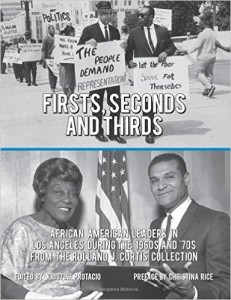 Firsts, Seconds and Thirds: African American Leaders in Los Angeles from the 1960s and ’70s from the Rolland J. Curtis Collection Firsts, Seconds and Thirds: African American Leaders in Los Angeles from the 1960s and ’70s from the Rolland J. Curtis Collection
Civil Rights took shape in 1960s Los Angeles as African Americans broke color barriers and began to occupy positions in government. Progress during this time extended past politics, to the realm of entertainment, commerce, public service and activism. It is in the midst of this exciting time that Rolland J. Curtis (right) took thousands of photographs while serving as a Field Deputy for Council Members Billy Mills and Tom Bradley. Curtis’ images provide a unique view of the African American experience in South Los Angeles during this time. This book presents a sampling of Curtis’ photographic archive, now housed at the Los Angeles Public Library, as well as a glimpse at some of the city’s black leaders of the period. Some famous, some forgotten, these individuals were true trailblazers: the first, second, or third African Americans in the history of Los Angeles to accomplish their feats. |
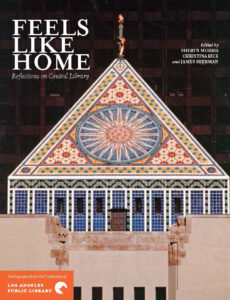 Feels Like Home: Reflections on Central Library Feels Like Home: Reflections on Central Library
On April 29, 1986, an arson fire devastated Central Library, damaging the building and destroying parts of its vast collection. Months later, a second fire did even more damage. While renovation and expansion plans were already in the works, the tragic events galvanized the public and cemented the devotion of an already dedicated staff. On October 3, 1993, Central Library re-opened its doors to a jubilant city, and 25 years later Central Library still fulfills its promise as a “light of learning.” To commemorate this milestone, Central Library staff and volunteers recount their memories and reflect on a space that has made an impact on all those who walk through its doors. |
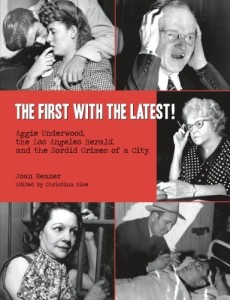 The First with the Latest!: Aggie Underwood, the Los Angeles Herald, and the Sordid Crimes of a City The First with the Latest!: Aggie Underwood, the Los Angeles Herald, and the Sordid Crimes of a City
Agness “Aggie” Underwood never intended to become a reporter—all she really wanted was a pair of silk stockings. When her husband told her they couldn’t afford them, she threatened to get a job and buy them herself. Those silk stockings launched a career that started with Aggie at the switchboard of the Los Angeles Record newspaper in 1926, and ended more than four decades later when she retired as City Editor of the Los Angeles Herald Examiner. As a reporter for the Los Angeles Evening Herald and Express (later, Herald Examiner), Aggie not only reported on crimes throughout the city, but sometimes helped solve them. Using quick wit and intuition, Aggie helped her newspaper live up to its motto “The First with the Latest.” Through the Los Angeles Herald Examiner’s photo archive, now held by the Los Angeles Public Library, the cases Aggie covered are more than just faded headlines, but come to life in light and shadow. This catalog of nearly 100 images, which compliments an exhibit at the Los Angeles Public Library’s Central Library gives a brief overview of Agness Underwood and some of the cases she covered. |
 From Pop to the Pit: LAPL Photo Collection Celebrates the Los Angeles Music Scene, 1978-1989 From Pop to the Pit: LAPL Photo Collection Celebrates the Los Angeles Music Scene, 1978-1989
Los Angeles has always enjoyed a tremendous amount of diversity, both culturally and geographically. In the 1980s, these varied ethnic and socio-economic backgrounds combined with the environmental influences of the beach, suburbs, or inner-city created an astoundingly unique and memorable period for popular music with L.A. at the epicenter. Culled from the Los Angeles Public Library’s Herald Examiner photo archive and the Gary Leonard Collection, LAPL and Photo Friends present a glimpse into a decade that produced scores of hit singles, showcased strikingly diverse genres and generated tremendous excitement. The exhibit From Pop to the Pit: LAPL Photo Collection Celebrates the Los Angeles Music Scene, 1978-1989 and companion catalog relive an extraordinary time in music history with rarely seen images of the bands that helped define the era. |
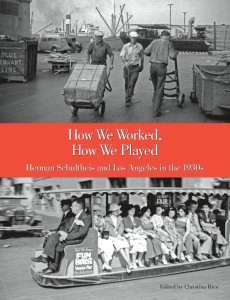 How We Worked, How We Played: Herman Schultheis and Los Angeles in the 1930s How We Worked, How We Played: Herman Schultheis and Los Angeles in the 1930s
Herman Schultheis may have been an engineer by trade, but was a photographer at heart who never seemed to go anywhere without his camera. After relocating to Los Angeles from the East Coast in 1937, Herman and his wife Ethel explored their newly adopted home, far and wide. By the end of the decade, he had snapped well over 5,000 photos. How We Worked, How We Played: Herman Schultheis and Los Angeles in the 1930s, presents a small sampling of this amazing collection which was donated to the Los Angeles Public Library following Ethel’s death in the early 1990s. The images present an overview of a rapidly expanding city in the midst of the Great Depression and on the verge of World War II, along with the simple story of two people in love with each other–and Los Angeles. |
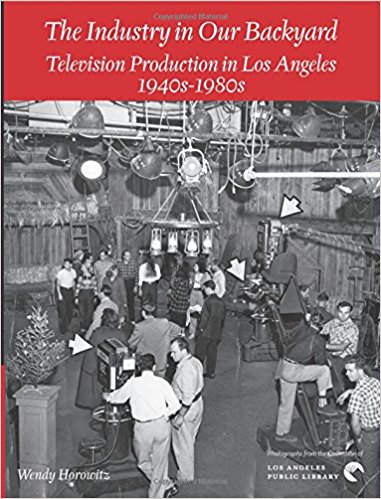 The Industry in Our Backyard: Television Production in Los Angeles 1940s-1980s The Industry in Our Backyard: Television Production in Los Angeles 1940s-1980s
From Lucy to ALF, from game shows to talk shows, from local news to the made-for-TV movie, The Industry in Our Backyard: Television Production in Los Angeles 1940s–1980s showcases five decades in the life of the medium that dominated American culture, yet for Angelenos, was just another part of daily life. The images displayed in the exhibit were largely taken by photographers from the Herald Examiner and the Valley Times newspapers, who were granted exclusive access to back lots, sound stages and location shoots around town for their TV sections. These photos, which have not been seen in as many as sixty-five years when they first ran in the papers, provide rare glimpses of the earliest L.A. stations, the crews at work and the stars in action. |
 L.A. Baseball: From the Pacific Coast League to the Major Leagues L.A. Baseball: From the Pacific Coast League to the Major Leagues
Like all of America, Los Angeles first caught baseball fever in the 19th Century. The sport that writers dubbed the national pastime soon spread to every part of the Southland. Members of Riverside’s Cahuilla Indian tribe played ball, Issei immigrants from Japan played besuboru, Mexican American kids played béisbol. African American players from the Negro Leagues gathered for wintertime training, while talented local ballplayers stocked the rosters of Major League teams: Fred Snodgrass, Walter Johnson, John “Chief” Meyers, Gavvy Cravath.As the game exploded in popularity, the Los Angeles Angels and the Hollywood Stars of the Pacific Coast League provided an exciting and entertaining brand of Minor League baseball. The arrival of the Dodgers from Brooklyn in 1958, a controversial decision that continues to be debated to this day, finally brought Major League Baseball to L.A. (with the Angels arriving in the American League in 1961). The Los Angeles Public Library’s photo collection supplied the images for this book (and the accompanying exhibition). Many of the pictures were originally published in the Valley Times and Herald-Examiner newspapers. Others came from the groundbreaking “Shades of L.A.” project. Together, they capture L.A.’s unique contribution to the national pastime: famous players and anonymous weekend warriors; changes in uniform style and ballpark architecture; and the timeless essence of a game roiled by social change. Play Ball! |
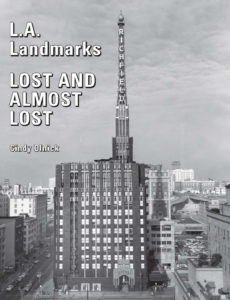 L.A. Landmarks Lost and Almost Lost L.A. Landmarks Lost and Almost Lost
What’s your favorite Los Angeles landmark? Does it still stand, or is it just a memory? From famous icons to hidden gems, Los Angeles has amazing architecture as diverse as the city itself. But L.A.’s long tradition of reinvention has left beloved landmarks in its wake. This book highlights just a few of the many great buildings that fell to the wrecking ball, as well as some that narrowly escaped. The landmarks we almost lost might surprise you, and their survival offers hope for a future that celebrates our past. |
|
In the late 1970s, the Olympic Movement was in deep trouble. When the International Olympic Committee called for candidates to host the 1984 Summer Olympics, only two cities expressed interest: Tehran and Los Angeles. And, after Tehran dropped out of the bidding process, L.A. was left to carry the flickering Olympic torch. Naysayers predicted disaster: the traffic would be snarled and the smog suffocating; the Games would bankrupt the city of L.A. and terrorists would harm innocent people. But L.A. proved everyone wrong. The weather cooperated, and the traffic was smooth sailing. An ambitious Arts Festival drew appreciative crowds, and pin trading became an unofficial Olympic event. And, who could not be thrilled by the record-setting performances of Carl Lewis, Evelyn Ashford, Edwin Moses, Joan Benoit, Daley Thompson, Mary Lou Retton, Greg Louganis, and Cheryl Miller? This book chronicles the 1984 Los Angeles Olympics through the extraordinary photographs taken by the staff at the Herald Examiner newspaper, a collection now held at the Los Angeles Central Library: from the preparations before the Games to the Opening Ceremony to the wondrous athletic performances to the Closing Ceremony. The 1984 Olympics were a golden moment in these photographers’ careers as well as for the city of Los Angeles. |
|
LA has known its share of notorious murderers. Hickman, Glatman, Bashor, Sirhan, Manson, Turner, Bianchi and Buono, just to name an ugly few. These remain stories told once and again. Tragic cases that commanded varying degrees of attention. None upset the urban routine like the Night Stalker. His crimes activated insecurities previously foreign to Angelenos. Brutal and unthinkable killings moved millions to a state of near lockdown. Law enforcement’s simultaneous scramble aimed to calm the masses and catch a killer. The effect on the millions of innocents was patently unfair, but proved abundantly necessary. The social impact of the serial killings and serial crimes committed by Richard Ramirez is discussed by a number of contributors who bolted doors, locked windows and took up arms in the heat of just a single summer. It was 1985.It was Satan’s Summer in the City of Angels. |
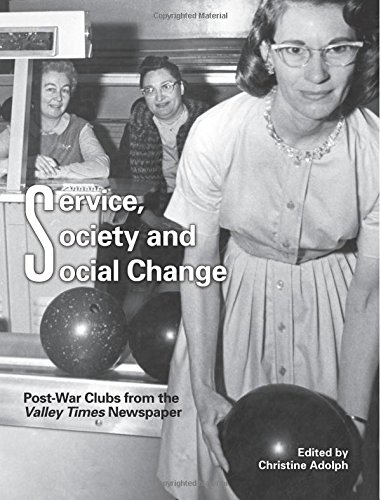 Service, Society and Social Change: Post-War Clubs from the Valley Times Newspaper Service, Society and Social Change: Post-War Clubs from the Valley Times Newspaper
The post-War San Fernando Valley was the quintessential American suburb. With the availability of affordable housing and jobs from the thriving aerospace, aircraft, and manufacturing industries, the Valley’s population boomed. The promise of prosperity inspired new opportunities for leisure time, family life and civic engagement. Membership in social and service clubs soared. Whether people united through shared identities or shared interests in hobbies, civics or philanthropy, the prevalence of club life defined the Valley’s growing community. The Valley Times newspaper, published from 1946 to 1970, documented the changes to the Valley’s physical landscape through suburban development, but also revealed how social networks impacted society. This latest entry from Photo Friends Publications accompanies the exhibit “Service, Society and Social Change: Post- War Clubs from the Valley Times Newspaper” (July 7, 2016 – January 15, 2017) and presents a sampling of images from the Valley Times photo archive, now held at the Los Angeles Public Library. Through the lens of the Valley Times photographers, we are presented with a unique visual history of the ways people connect to build a community. |
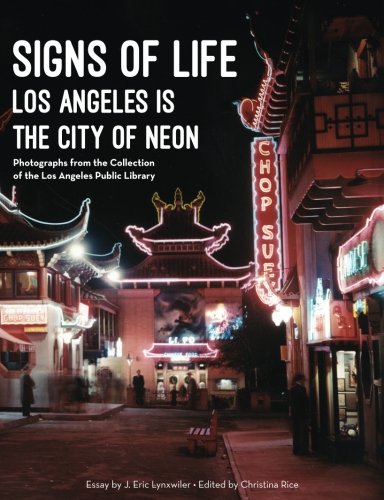 Signs of Life: Los Angeles Is the City of Neon Signs of Life: Los Angeles Is the City of Neon
Neon isn’t native to Los Angeles, but it’s difficult to picture the city without it. Every aspect of our lives has been spelled out in neon tubes across the United States, but Los Angeles is the king of that advertising glow. No other landscape could match its sheer quantity of signs in this city that grew up with the automobile. This latest exhibit from Photo Friends and the Los Angeles Public Library Photo Collection celebrates the city’s long and bright history with this unique type of illumination. Here is Los Angeles, City of Neon. |
 The Wilshire Slides 1978-1979 The Wilshire Slides 1978-1979
It was a heck of an after-school project for a mother and daughter: do an informal photo survey of the Wilshire Boulevard from downtown to the ocean. Mother Marlene was a Michigan native who’d come to L.A. in the late 1950s and loved everything about the city, especially the architecture. Daughter Annie liked the architecture too, and loved using her mom’s Minolta camera. Together, they spent about a dozen Tuesday afternoons in 1978-9 walking Wilshire; Marlene taking notes and Annie taking pictures. The result was over 1000 Kodachrome slides, documenting L.A.’s iconic street from its great landmarks to its empty lots. In 2010, Annie donated the Wilshire slides to the Los Angeles Public Library Photo Collection. Nearly 40 years later, the slides have turned into a unique time capsule of a boulevard that is in a constant state of change. While many buildings (and palm trees) remain intact, much of what Annie and Marlene captured now only exists on their Kodachrome slides. This latest entry from Photo Friends Publications takes a closer look at some of the Wilshire slides, selected by Annie Laskey as she looks back on those Tuesday afternoons she spent with her mom on Wilshire Boulevard. |

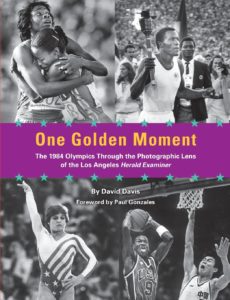
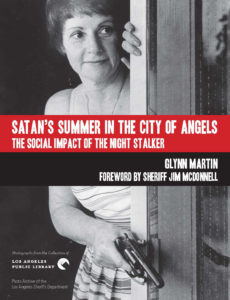 Satan’s Summer in the City of Angels: The Social Impact of the Night Stalker
Satan’s Summer in the City of Angels: The Social Impact of the Night Stalker